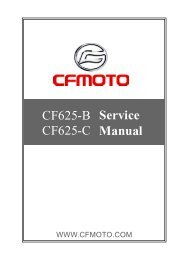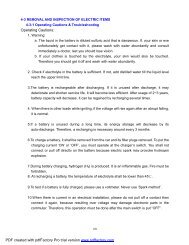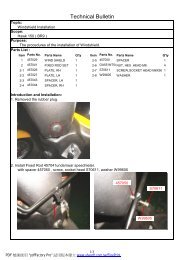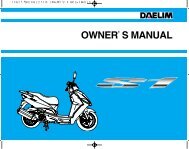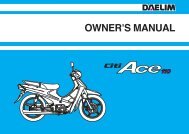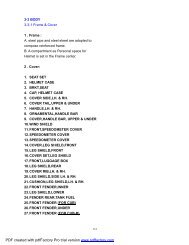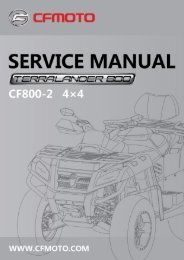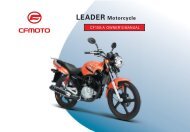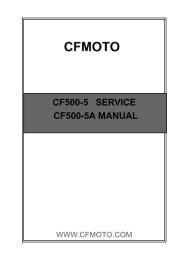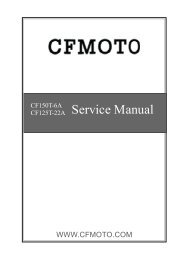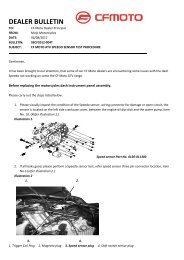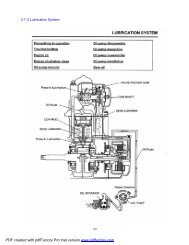Daelim S4 Owners Manual.pdf - Mojo Motorcycles
Daelim S4 Owners Manual.pdf - Mojo Motorcycles
Daelim S4 Owners Manual.pdf - Mojo Motorcycles
- No tags were found...
Create successful ePaper yourself
Turn your PDF publications into a flip-book with our unique Google optimized e-Paper software.
OWNER S MANUAL
IMPORTANT NOTICE<br />
WELCOME<br />
Thank you for purchasing an <strong>Daelim</strong> vehicle. We hope you enjoy safe riding.<br />
OPERATOR AND PASSENGER<br />
This motorcycle is designed to carry the operator and one passenger.<br />
WARNING<br />
Attempting to change the pre-set maximum speed may cause danger and will void the <strong>Daelim</strong> warranty.<br />
ON-ROAD USE<br />
This motorcycle is designed to be used only on the road.<br />
READ THIS OWNER'S MANUAL CAREFULLY<br />
Pay special attention to statements preceded by the following words:<br />
WARNING<br />
Indicates a strong possibility of severe personal injury or death if instructions are not followed.<br />
CAUTION<br />
Indicates a possibility of personal injury or equipment damage if instructions are not followed.<br />
NOTE<br />
Gives helpful information.<br />
This manual is an important and integral part of your vehicle. keep it with your vehicle at all times, even though your vehicle is resold.
CONTENTS<br />
SPECIFICATION<br />
OPERATION INSTRUCTION<br />
3<br />
4<br />
EQUIPMENT USAGE<br />
STEERING STEM LOCK<br />
14<br />
14<br />
SAFETY PRECAUTIONS<br />
4<br />
SEAT LOCK<br />
14<br />
PRIOR TO STARTING VEHICLE<br />
5<br />
TRUNK<br />
15<br />
OPERATION<br />
5<br />
STORAGE AREA<br />
15<br />
CORRECT ATTIRE<br />
CARGO<br />
6<br />
7<br />
BAG HOLDER<br />
OPERATION<br />
15<br />
16<br />
ATTACHMENT<br />
7<br />
CORRECT DRIVING OPERATION<br />
16<br />
MODIFICATION<br />
7<br />
STARTING THE ENGINE<br />
16<br />
MUFFLER<br />
7<br />
AFTER STARTING ENGINE<br />
18<br />
PARTS LOCATION<br />
8<br />
PROPER DRIVING METHODS<br />
19<br />
METER READING AND USAGE<br />
METER<br />
10<br />
10<br />
BRAKING<br />
SELF INSPECTIONS BEFORE OPERATION<br />
20<br />
22<br />
VIN INFORMATION AND LOCATION<br />
11<br />
INSPECTION OF CONCERNED AREA<br />
22<br />
FRAME NUMBER, ENGINE NUMBER<br />
11<br />
REAR VIEW MIRROR<br />
22<br />
VIN PLATE LOCATION<br />
11<br />
FUEL LEAK INSPECTION<br />
22<br />
SWITCH OPERATION<br />
12<br />
BRAKE INSPECTION<br />
23<br />
MAIN SWITCH<br />
12<br />
FUEL CHECK<br />
23<br />
START BUTTON<br />
12<br />
TIRE INSPECTION<br />
24<br />
HEADLIGHT<br />
13<br />
ENGINE OIL LEVEL CHECK<br />
26<br />
WINKER SWITCH<br />
13<br />
LIGHTS AND WINKER INSPECTION<br />
26<br />
HORN BUTTON<br />
14<br />
BULB REPLACEMENT METHOD<br />
27<br />
1
MAINTENANCE<br />
29<br />
SAFE DRIVING<br />
43<br />
MAINTENANCE SCHEDULE<br />
30<br />
DRIVING METHOD<br />
44<br />
MAINTENANCE PRECAUTIONS<br />
32<br />
DRIVING POSITION<br />
44<br />
THE ADJUSTMENT OF FREE PLAY OF REAR BRAKE LEVER<br />
32<br />
TAKING POSE OF FELLOW PASSENGER<br />
45<br />
CHECKING THE REAR BRAKE SHOE<br />
32<br />
PRECAUTION WHEN DRIVING<br />
46<br />
BRAKE HOSE, PIPE LEAKAGE, DAMAGE, ASSEMBLY STATE<br />
34<br />
STARTING<br />
47<br />
BRAKE PAD WEAR<br />
34<br />
TURNING METHOD<br />
48<br />
CHANGING ENGINE OIL<br />
34<br />
PRINCIPLE OF TURN<br />
48<br />
TRANSMISSION OIL INSPECTION<br />
36<br />
EFFECT OF SPEED<br />
48<br />
SPARK PLUG<br />
37<br />
3 POSITIONS OF TURNING<br />
49<br />
BATTERY INSPECTION<br />
38<br />
TURNING METHOD<br />
50<br />
FUSE REPLACEMENT<br />
39<br />
PRECAUTION WHEN TURNING<br />
51<br />
AIR CLEANER ELEMENT INSPECTION<br />
40<br />
BRAKING METHOD<br />
52<br />
SIDE STAND INSPECTION<br />
41<br />
BASIC PRINCIPLE OF BRAKE(FRICTION FORCE)<br />
52<br />
CABLE RUBBER PART<br />
41<br />
RESTRAINT OF BRAKING EFFECT (INERTIA)<br />
52<br />
CLEANING<br />
42<br />
BRAKING METHOD<br />
53<br />
STORAGE<br />
42<br />
COMPARISION OF BRAKING DISTANCE<br />
53<br />
IMPACT WHEN COLLISION<br />
53<br />
WIRING DIAGRAM<br />
54<br />
2
SPECIFICATION<br />
ITEM DATA ITEM DATA<br />
LENGTH×WIDTH×HEIGHT(mm)<br />
1,790×680×1,110<br />
IGNITION SYSTEM<br />
C.D.I<br />
WHEEL BASE(mm)<br />
1,265<br />
BATTERY CAPACITY<br />
12V6AH(MF TYPE)<br />
SEAT HEIGHT(mm)<br />
766<br />
FUEL CAPACITY(l)<br />
5.0<br />
DRY WEIGHT(kgf)<br />
88<br />
RESERVE FUEL CAPACITY(l)<br />
1.5<br />
PASSENGER<br />
ENGINE TYPE<br />
PISTON DISPLACEMENT(cc)<br />
2<br />
AIR COOLED<br />
4 STROKE 2VALVE<br />
49.6<br />
TIRE SIZE<br />
SUSPENSION<br />
FR.<br />
RR.<br />
FR.<br />
RR.<br />
110 / 70 - 12, 47J<br />
120 / 70 - 12, 56J<br />
TELESCOPIC<br />
UNIT SWING OIL DAMPER<br />
BORE AND STROKE(mm)<br />
STARTING SYSTEM<br />
39×41.5<br />
START MOTOR / KICK<br />
BRAKE<br />
FR.<br />
RR.<br />
DISK BRAKE<br />
DRUM BRAKE<br />
TRANSMISSION TYPE<br />
CVT<br />
SPARK PLUG<br />
FUSE(A)<br />
CR6HSA<br />
10<br />
3
OPERATION INSTRUCTION<br />
This manual describes matters pertaining to correct operation,<br />
safe operation and simple maintenance of the vehicle you<br />
purchased.<br />
To ensure more comfortable and safer operation, make sure to<br />
read this manual carefully prior to operation.<br />
●The photographs and drawings shown in this manual may<br />
differ from those of actual vehicles due to changes in vehicle<br />
specifications and modifications made.<br />
●This vehicle is designed for 2 riders including the operator.<br />
CAUTION<br />
● Do not use polluted gasoline.<br />
Using polluted gasoline will cause rust inside the fuel<br />
tank, and will close the supply of fuel to the<br />
carburetor, leading to an improper engine starting or<br />
may cause serious damage to an engine.<br />
● Do not use polluted or low-grade oil.<br />
Always use genuine oil to protect and extend vehicle<br />
performance and its life span.<br />
● If any failure occurs due to the use of polluted gasoline<br />
or oil, such failure will be excluded from being eligible<br />
for repairs under the warranty.<br />
● As far as any defect caused by contaminated gasoline or<br />
oil, the warranty will be automatically invalidated.<br />
SAFETY PRECAUTIONS<br />
●Careful driving and the wearing of proper attire and safety<br />
equipment are the most important factors in the safe operation<br />
of the scooter. Please obey traffic regulations and do not be<br />
hurried and careless.<br />
●Many new vehicle owners operate their newly purchased<br />
vehicles with great care and attention to safety factors.<br />
However, after becoming accustomed to the operations are<br />
often discarded, which can lead to accidents. Please don't let<br />
this happen to you and always approach the operation of your<br />
vehicle with the safety considerations needed.<br />
When operating the vehicle, always keep in mind and obey the<br />
notes of precaution printed on the “Safety Precaution Label”<br />
attached to the vehicle.<br />
● Be sure to wear helmet at all time.<br />
● Be sure to put on gloves at all time.<br />
● Observe the speed regulations.<br />
● Beware of muffler affer driving as it is still hot to be<br />
burnt.<br />
Especially never children touch on it.<br />
● For safety, do not change, alteration or modification the<br />
vehicle.<br />
● Regularly conduct specified maintenance inspections.<br />
<br />
Brakes, Tires, Oil, Lights, Horn, Instruments<br />
4
PRIOR TO STARTING VEHICLE<br />
●Read user's manual carefully.<br />
●Conduct maintenance checks prior to operation.<br />
●Always maintain vehicle in clean status and carry out specified<br />
maintenance checks.<br />
●Make sure to stop engine and stay away from fire when<br />
fueling.<br />
●Exhaust gas contains harmful substance such as carbon<br />
monoxide. Start engine in well-ventilated places.<br />
OPERATION<br />
● Operators should naturally fix bodies to keep smooth driving.<br />
●Please check whether or not you are unnaturally strained and<br />
strung up.<br />
●Driving pose has a great influence on safe operation.<br />
Please always maintain the center of your body in the middle of<br />
seat. Especially do not sit at the rear seat because it may lessen<br />
the weight of front wheel and cause trembling steering wheel.<br />
●A passenger should hold on to the vehicle or the operator with<br />
both hands and keep both feet on the pillion step bar.<br />
●When wanting to turn, slightly lean to body toward the<br />
direction of the turn. It is unsafe if the body is not moved in<br />
union with the vehicle.<br />
●Curvy roads and poor, unpaved roads constantly change in<br />
surface quality. Driving on these roads can be unsafe if certain<br />
safety precautions are not followed.<br />
●In order to safely drive through these driving conditions,<br />
anticipate coming road conditions, slow down to at least half<br />
the normal speed, and relax your shoulders and wrists while<br />
securely holding the handles.<br />
5
CORRECT ATTIRE<br />
●Always make sure to wear helmet for safety. Wear gloves and<br />
safety goggles.<br />
●Do not wear uniforms which might hinder operation. It is<br />
dangerous if the uniform is caught by brake lever or by the<br />
rotating part of drive chain.<br />
●Many automobile/motorcycle accidents happen because the<br />
automobile driver does not “see” the motorcyclist.<br />
Make yourself conspicuous to help avoid the accident that<br />
wasn’t your fault :<br />
- Wear bright or reflective clothing.<br />
- Don’t ride in another motorist’s “blind spot”.<br />
Correct shirts or jackets with<br />
tight-fitting sleeves should be<br />
worn,<br />
A helmet should always be<br />
worn and the helmet chin<br />
strap should be securely<br />
fastened.<br />
WARNING<br />
● Be sure you and your passenger always wear a helmet,<br />
eye pretection and other protective apparel when you<br />
ride.<br />
● Not wearing a helmet increases the chance of serious<br />
injury or death in a crash.<br />
Always put on gloves.<br />
Shoes should fit properly, and shoes having little or<br />
no heel should be worn.<br />
6
CARGO<br />
●When carrying cargo, you must keep in mind that operating the<br />
motorcycle, especially when turning, will be different.<br />
●Make sure not to overload the motorcycle with goods as this<br />
can make the motorcycle unstable during operation.<br />
TRUNK MAXIMUM LOAD : 10kg<br />
MODIFICATION<br />
●Modification of vehicle structure of function deteriorates<br />
manipulatability or causes exhaust noise to become louder<br />
shortening the vehicle life. These modifications are not only<br />
prohibited by law but also are the acts harmful to other people.<br />
Modifications are not covered by warranty.<br />
MUFFLER<br />
●Pay particular attention to fellow passenger so that he/she can<br />
prevent getting burnt by the hot muffler during travel.<br />
WARNING<br />
● Overloading or improper loading can cause a crash and<br />
you can be seriously hunt.<br />
● Follow all load limits in this manual.<br />
ATTACHMENT<br />
●Except designated attachment by DAELIM MOTOR CO.,<br />
LTD., don't attach any extra lighting device, because it may<br />
cause an early discharging of battery.<br />
CAUTION<br />
● Beware of muffler after driving as it is still hot to be<br />
burnt. Especially never children touch on it. And pay<br />
attention to park where pedestrian zoon.<br />
● If haystack or vinyl is stuck to the muffler, it might be<br />
fired.<br />
7
PARTS LOCATION<br />
SPEEDOMETER<br />
REAR CARRIER<br />
SEAT<br />
FR. BRAKE LEVER<br />
SIDE REFLECTOR<br />
RR. WINKER<br />
(TURN SIGNAL)<br />
FR. WINKER<br />
(TURN SIGNAL)<br />
FR. BRAKE DISK<br />
MUFFLER<br />
FR. TIRE<br />
BRAKE CALIPER<br />
RR. TIRE<br />
MAIN STAND<br />
BATTERY COVER<br />
8
PARTS LOCATION<br />
RR. BRAKE LEVER<br />
BAG HOLDER<br />
SEAT<br />
RR. WINKER<br />
HEADLIGHT<br />
FR. FENDER<br />
REAR COMBI.<br />
LIGHT<br />
RR. CUSHION<br />
FR. CUSHION<br />
AIR CLEANER<br />
FR. TIRE<br />
SIDE STAND<br />
KICK START<br />
9
METER READING AND USAGE<br />
METER<br />
<br />
Indicates driving speed. Maintain legal<br />
speed limits to ensure safe operation.<br />
<br />
Indicates total distance in kilometers<br />
travelled by the vehicle.<br />
WINKER<br />
INDICATOR<br />
SPEEDOMETER<br />
WINKER<br />
INDICATOR<br />
<br />
The fuel meter indicates the gasoline level<br />
inside the fuel tank.<br />
Gasoline should be put in the fuel tank as<br />
soon as possible if the needle is resting in<br />
the red area.<br />
FUEL TANK MAXIMUM CAPACITY : 5.0<br />
RESERVIOR CAPACITY : 1.5<br />
10<br />
20<br />
0 0 10<br />
30 40 50<br />
20<br />
Mph<br />
30<br />
40<br />
50<br />
60<br />
70<br />
80<br />
FUEL METER<br />
<br />
When the winker switch is operated,<br />
the winker indicator flashes in union<br />
with the flashing of the turn signals.<br />
ODOMETER<br />
HEADLIGHT<br />
HIGHBEAM<br />
INDICATOR<br />
.<br />
WARNING<br />
● To avoid running out of fuel,it might<br />
cause severe injury due to engine<br />
abruptly stop.<br />
10
VIN INFORMATION AND LOCATION<br />
FRAME NUMBER, ENGINE NUMBER<br />
●The frame number, engine number are<br />
needed when registering your<br />
motocycle.<br />
●They may also be required by your<br />
dealer when ordering replacement parts.<br />
●Record the numbers along with the<br />
vehicle license plate number and keep<br />
them separately from the vehicle.<br />
<br />
The engine number is stamped on the<br />
lower part of the left crankcase.<br />
VIN PLATE LOCATION<br />
VIN plate is located on the left engine<br />
hanger plate.<br />
<br />
The frame number is stamped on the front<br />
central part of the frame.<br />
FRAME<br />
NUMBER<br />
ENGINE NUMBER<br />
DAELIM MOTOR CO., LTD.<br />
<br />
<br />
<br />
11
SWITCH OPERATION<br />
MAIN SWITCH<br />
ON<br />
OFF<br />
MAIN SWITCH<br />
KEY<br />
1. ON.... Starts engine. Key can not be<br />
pulled out.<br />
2. OFF....Stops engine. Key can be<br />
placed in or taken out of the<br />
main switch.<br />
3. LOCK....Locks handle bars. Key can be<br />
placed in or taken out of the<br />
main switch.<br />
4. OPEN....When seat lock is released,<br />
key returns to its original<br />
position(OFF). Key can be<br />
placed in or taken out of the<br />
main switch.<br />
CAUTION<br />
START BUTTON<br />
START BUTTON<br />
The engine is started pressing this button<br />
when pressed in a state where the main<br />
switch key is placed to an ON position<br />
and the brake lever is pulled.<br />
LOCK<br />
● When you park the vehicle and<br />
leave it, please lock handle bars and<br />
take out the key.<br />
● Rotate key smoothly without<br />
pressing to turn to OPEN.<br />
● The headlight will be on automatically.<br />
when the key is on, so do<br />
not remove this electric circuit<br />
otherwise, it may cause severe injure<br />
when driving in the night.<br />
CAUTION<br />
● The engine will not start if the brake<br />
lever is not pulled.<br />
● Do not hold the brake lever and<br />
the throttle grip when the engine was<br />
started. It may damage the engine.<br />
12
HEADLIGHT<br />
<br />
Put main switch key in “ON” position and<br />
turn on headlight switch.<br />
HEADLIGHT SWITCH<br />
<br />
High beam or low beam can be operated<br />
by the use of dimmer switch.<br />
HIGH BEAM<br />
D(HI) ...... use when needing extra<br />
light.<br />
LOW BEAM<br />
D(LO) ...... use when other vehicles are<br />
present, in the city, etc.<br />
DIMMER SWITCH<br />
WINKER SWITCH<br />
WINKER SWITCH<br />
If this switch is turned on when the main<br />
switch is in an ON position, the winker will<br />
operate.<br />
⇨ (R)....used when making a right turn.<br />
⇦ (L)....used when making a left turn.<br />
SWITCH POSITION<br />
(H)<br />
(P)<br />
(OFF)<br />
FUNCTION<br />
Headlight, taillight,<br />
position lamp and<br />
meter lights on.<br />
Position lamp, taillight,<br />
and meter lights on.<br />
Light turned off.<br />
CAUTION<br />
● Use the high beam only in the<br />
suburban road or when the usage of<br />
the high beam not hinder the safe<br />
driving of the car ahead.<br />
CAUTION<br />
● The winker switch does not automatically<br />
turn back to its original<br />
position after completing the turn.<br />
● Please set the switch back to its<br />
center position after turning.<br />
13
HORN BUTTON<br />
HONE BUTTON<br />
The horn is sounded if the horn button is<br />
pressed when the main switch is in an ON<br />
position.<br />
EQUIPMENT USAGE<br />
STEERING STEM LOCK<br />
<br />
To lock the steering, turn the handlebars<br />
all the way to the left, turn the key to<br />
LOCK while pushing in. Remove the key.<br />
<br />
To unlock the steering, turn the key to the<br />
OFF position.<br />
WARNING<br />
STEERING<br />
STEM LOCK<br />
KEY<br />
● Do not turn the key to LOCK while<br />
riding the vehicle; loss of vehicle<br />
control will result.<br />
SEAT LOCK<br />
<br />
The seat automatically locks when the<br />
seat is pushed in its downward position,<br />
Lightly pull upward on the seat to make<br />
sure the seat has been properly locked.<br />
<br />
Turn the main switch key from OFF to<br />
OPEN to open the seat.<br />
CAUTION<br />
● As the seat automatically locks, take<br />
special care not to accidently leave the<br />
key in the trunk.<br />
● Make sure that the seat is securely<br />
locked after closing the seat.<br />
Driving with unlocked seat lock may<br />
cause danger.<br />
● When the seat lock is out of order, do<br />
not operate it further and inspect it in<br />
the closest authorized repair center.<br />
14
TRUNK STORAGE AREA BAG HOLDER<br />
TRUNK<br />
CHARGE SOCKET<br />
●There is a trunk under the seat.<br />
●The seat is opened to gain access to the<br />
trunk by using the main switch key on<br />
the seat lock.<br />
TRUNK MAXIMUM LOAD:10kg<br />
CAUTION<br />
● The temperature inside the trunk<br />
rises due to heat from the engine. Do<br />
not place foodstuffs and other articles<br />
that can be damaged easily by heat.<br />
Also do not place flamm-able<br />
materials in the trunk.<br />
● Do not place valuable or fragile<br />
goods in trunk.<br />
STORAGE AREA<br />
●Store small notebook and stuffs in this<br />
area.<br />
CAUTION<br />
● As water can enter the trunk when<br />
washing, make sure to remove<br />
articles that can be damaged by<br />
water.<br />
●For ease in carrying bags and similar<br />
items, they should be hung from the<br />
bag holder which is fitted for this<br />
purpose.<br />
●When using the bag holder, place it in<br />
the open position and return it to the<br />
normal position when not in use.<br />
CAUTION<br />
BAG HOLDER<br />
● Do not attempt to carry very heavy or<br />
bulky loads since this would affect the<br />
stability and steering characteristics of<br />
the scooter.<br />
15
OPERATION<br />
CORRECT DRIVING OPERATION<br />
●Make sure to check the oil, gasoline,<br />
etc., before starting the engine.<br />
●Please ensure that the main stand is in a<br />
down position when starting the engine.<br />
CAUTION<br />
● Make sure that the rear wheel is<br />
locked when starting the engine to<br />
prevent an unexpected quick start of<br />
the vehicle.<br />
● Locking is not possible if the rear<br />
wheel brake is not adjusted correctly.<br />
●Drive with care for both safety reasons<br />
and longer vehicle life.<br />
●For 1 month (or 1,000km) after purchasing<br />
the vehicle, drive moderatly<br />
avoiding fast starts and fast acceleration<br />
STARTING THE ENGINE<br />
WARNING<br />
● Never run the engine in an enclosed<br />
area. The exhaust contains<br />
poisonous carbon monoxide gas that<br />
can cause loss of consciousness and<br />
lead to death.<br />
Lock the rear wheel.<br />
Turn the main switch to an ON<br />
position.<br />
Press the starter button without<br />
rotating the starter grip (opening the<br />
throttle).<br />
16
When the engine is cold morning or<br />
winter or the vehicle has not been used<br />
for a long period of time, let the<br />
engine idle for a short period allow the<br />
engine to warm up.<br />
●If the engine is hot and does not start ●It is possible that starting will be more<br />
after pressing the starter button for 3~4 difficult if the vehicle has not been used<br />
seconds, rotate the throttle grip to for a long period of time or if the fuel<br />
1/8~1/4 of a rotation and try again. This hole is plugged up(starting problems<br />
will allow easy starting<br />
even when there is sufficient fuel in the<br />
fuel tank may be an indication of a<br />
CAUTION<br />
plugged fuel hole).<br />
CAUTION<br />
When this happens, do not rotate the<br />
● Immediately release the starter button<br />
throttle grip and try the starter button a<br />
as soon as the vehicle has started.<br />
few times.<br />
● Do not press the starter button when<br />
the engine is running.<br />
CAUTION<br />
This can damage the starting motor.<br />
● Do not keep the statter button pressed<br />
for more than 5 seconds at a time.<br />
1/4 1/8 Release the starter button for<br />
approximately 10 seconds before<br />
pressing it again.<br />
● Keep holding rear brake until start.<br />
● Exhaust has contains harmful substance<br />
such as carbon monoxide.<br />
Start engine in well-ventilated places.<br />
<br />
If engine cannot be started or vehicle does<br />
not move, check the followings.<br />
●Is there fuel in fuel tank?<br />
●Are you operating in accordance with<br />
the instructions given in owner’s<br />
manual?<br />
●Is fuse not cut?<br />
●Is starter motor running?<br />
●If starter motor is not running due to<br />
battery consumption, try starting motor<br />
by using kick start technique.<br />
17
AFTER STARTING ENGINE<br />
Fold the main stand.<br />
●Push the vehicle forward to fold the<br />
main stand and make sure that the brake<br />
lever does not become released during<br />
this operation.<br />
Get on the vehicle.<br />
●Mounting should be done from the left<br />
side, and you should sit squarely on the<br />
seat. Leave either one foot or both feet<br />
planted on the ground<br />
Release the squeezing tension on the<br />
rear brake lever and slowly begin to<br />
rotate the throttle grip to allow for a<br />
slow and easy start.<br />
CAUTION<br />
● Do not excessively open the throttle<br />
until you actually start the driving<br />
operation of the vehicle.<br />
CAUTION<br />
● Keep holding rear brake lever before<br />
starting.<br />
CAUTION<br />
● A quick rotating of the throttle grip<br />
will cause the vehicle to move<br />
suddenly forward.<br />
● If the engine RPM isn’t decreased<br />
after the throttle grip return to its<br />
original position, stop operating and<br />
inspect it in the closest authorized<br />
repair center.<br />
18
PROPER DRIVING METHODS<br />
●Before entering traffic, use the correct<br />
turn signal to foreward other drivers of<br />
your intentions.<br />
Speed is controlled by the operation of<br />
the throttle grip.<br />
●If the throttle grip is rotated........<br />
The speed of the vehicle increases.<br />
Please rotate the throttle grip slowly.<br />
When climbing a hill, the throttle grip<br />
need to be rotated further to give the<br />
vehicle more power.<br />
Work the front and rear brakes<br />
together.<br />
●Allow the throttle grip to rotate back to<br />
its beginning position and then squeeze<br />
the brake levers.<br />
●If is best to operate the brakes by first<br />
lightly squeezing the brake levers and<br />
then changing to a more firm squeeze.<br />
●If the throttle grip is allowed to<br />
rotate back........<br />
Speed decreases. This can be done<br />
slowly or quickly, depending on how<br />
quickly you need to decelerate.<br />
RR. BRAKE<br />
FR. BRAKE<br />
ROTATE<br />
BACK ROTATE<br />
CAUTION<br />
● If only one of the brakes is used, it is<br />
possible for the vehicle to experience<br />
sliding.<br />
19
The brakes should never be suddenly<br />
applied and the handle bars should<br />
never be suddenly turned.<br />
●Sudden braking or turning can cause the<br />
vehicle to slide and tip over.<br />
●It is especially dangerous to perform<br />
sudden braking on wet roads or in rainy<br />
weather as the tires can lose traction<br />
and slip easily.<br />
Special care in driving should be<br />
taken during rainy weather.<br />
●More braking distance is needed when<br />
driving on wet roads or in the rain.<br />
Reduce speed and be sure to initiate the<br />
braking operation sooner than when<br />
driving in normal conditions.<br />
●On downgrades, allow the throttle grip<br />
to rotate back to its initial position to<br />
reduce speed, and apply the brakes and<br />
drive slowly down the hill.<br />
●It is possible for the brakes to<br />
temporarily lose operative ability after<br />
driving through a puddle or when<br />
driving in the rain. To ensure that the<br />
brakes are operating properly, slow<br />
down(after checking for other vehicles)<br />
and while driving slowly, lightly apply<br />
the brakes to rid the brakes of any<br />
excess water and to dry them.<br />
●Be extremely careful when driving in<br />
the snow or on icy roads.<br />
When driving in these conditions, both<br />
the tires lose much of their traction and<br />
the rear tire can slip when opening the<br />
throttle.<br />
BRAKING<br />
When approaching the desired<br />
stopping area.<br />
●Activate the proper winker, and after<br />
checking for other vehicles, slowly turn<br />
into the area in which you want to stop.<br />
●Allow the throttle grip to rotate completely<br />
back and apply the front and rear<br />
brakes. The brake light will shine to<br />
alert vehicles in back of you that you<br />
are stopping.<br />
RR. BRAKE<br />
FR. BRAKE<br />
20
After the vehicle has come to a<br />
complete stop.<br />
●Return the winker switch to the center<br />
position and turn the main switch to<br />
OFF. This will turn the engine off.<br />
Dismount on the left side and lower<br />
the main stand on a flat surface.<br />
●Be sure to park in an area that is free of<br />
traffic. Also, the vehicle can tip over if<br />
the main stand is not placed on a stable<br />
and flat surface.<br />
●The main stand is lowered by grasping<br />
the handle bars with the left hand,<br />
holding the rear carrier with the right<br />
hand, and stepping firmly on the stand<br />
with the right foot. In this position, lift<br />
the rear carrier upward, which will<br />
secure the main stand.<br />
To prevent theft, be sure to lock the<br />
steering when parking.<br />
CAUTION<br />
● Park in a safe area that will not block<br />
traffic. When you parked the vehicle<br />
after driving, make sure foot the<br />
vehicle beyond man’s reach because<br />
engine and muffler are still hot.<br />
● Park the motorcycle on firm, level<br />
ground to prevent it from failling<br />
over.<br />
● If you must park on a slight incline,<br />
aim the front of the motorcycle uphill<br />
to reduce the possibility of rolling off<br />
the side stand or overturning.<br />
CAUTION<br />
● Do not rotate the main switch key<br />
while driving. If the main switch is<br />
turned to an OFF or LOCK position,<br />
the electrical system will not operate.<br />
Operating the main switch key while<br />
driving can be very hazardous. Only<br />
turn the main switch key to OFF or<br />
LOCK position after completing<br />
stopping the vehicle.<br />
21
SELF INSPECTIONS BEFORE OPERATION<br />
Self inspect the vehicle and have regular<br />
maintenance inspections for increased<br />
safety and the prevention of accidents.<br />
Regular maintenance inspections should<br />
be performed even if the vehicle has not<br />
been used for a long period of time.<br />
Self inspections before operation should<br />
be performed on a daily basis prior to<br />
operating the vehicle.<br />
●Inspections of concerned Area<br />
●Brake inspection<br />
●Tire inspection<br />
●Fuel check<br />
●Engine oil check<br />
●Lights and winker inspection<br />
●Back mirror inspection<br />
●Fuel leak inspection<br />
●License plate inspection<br />
●Throttle grip inspection.<br />
CAUTION<br />
● Observe safety rules when<br />
conducting inspections.<br />
● Exhaust gas contains harmful<br />
substance such as carbon mono-xide.<br />
Do not carry out inspections on<br />
vehicle in closed places, or in poorly<br />
ventilated places, with engine<br />
running.<br />
● Conduct inspections on flat, solid<br />
ground with the stand erected.<br />
● Be careful of burns when conducting<br />
inspections immediately after engine<br />
is stopped because the engine and<br />
muffler are hot.<br />
● Stop engine and remove the key prior<br />
to the vehicle maintenance service.<br />
● Use appropriate types of tools.<br />
● If you are unable to correct trouble<br />
even after you make adjustment or<br />
correction, contact authorized<br />
maintenance shops, dealers or<br />
designated repair shops for necessary<br />
inspection and repairs.<br />
INSPECTION OF CONCERNED AREA<br />
●Check areas which caused for concern<br />
when last operating the vehicle.<br />
●If happened, contact authorized<br />
maintenance shops for necessary<br />
inspection and repairs.<br />
REAR VIEW MIRROR<br />
Check the objects at the back are well<br />
noticed when seating on a driver’s seat, and<br />
also mirror for damage or contamination.<br />
FUEL LEAK INSPECTION<br />
Check there is no gasoline leakage from fuel<br />
tank, hoses, carburetor, etc.<br />
22
BRAKE INSPECTION<br />
<br />
Lightly squeeze the brake levers until<br />
tension is felt to check for an appropriate<br />
amount of free play. No free play in the<br />
brake levers or overly loose brake levers<br />
are indication of a problem in the brake<br />
system.<br />
BRAKE LEVER FREE PLAY: 10~20mm<br />
FREE PLAY<br />
FREE PLAY<br />
<br />
This is checked by placing the vehicle on<br />
its main stand on a flat surface. Make sure<br />
that the handle bars are at a horizontal<br />
level. Check to see if the fluid is below the<br />
LOWER level.<br />
If brake fluid is significantly low, this may<br />
indicate that there is leakage in the brake<br />
system. Inspect the brake hose to check<br />
for leaks.<br />
FUEL CHECK<br />
<br />
Check gasoline to see if there is a sufficient<br />
amount of gasoline to reach your<br />
destination.<br />
●Place the main switch to “ON” position.<br />
●If the fuel meter needle indicates E<br />
mark (red portion), fill fuel tank with<br />
gasoline as soon as possible.<br />
Reserve fuel capacity : 1.5l<br />
FUEL METER<br />
THROTTLE GRIP<br />
CAUTION<br />
● Specified brake lever free play must<br />
be maintained. Excessive free play<br />
may cause long stopping distance,<br />
brake operational fault and slow<br />
reacting time resulting in the<br />
dangerous situation and insufficient<br />
free play may cause short stopping<br />
distance and damage brake<br />
system(pad, lining, etc.)<br />
CAUTION<br />
FR. BRAKE LEVER<br />
● If the brake fluid is significantly<br />
lower than the specified level, inspect<br />
not only brake fluid but also check<br />
the front brake pad for wear.<br />
10<br />
20<br />
0 0 10<br />
30 40 50<br />
20<br />
30<br />
Mph<br />
40<br />
50<br />
60<br />
70<br />
80<br />
E(RED ZONE)<br />
23
●Open the key cover on fuel tank cap,<br />
and turn the key clockwise to remove<br />
the cap.<br />
●Fill the tank with gasoline until it<br />
reaches the bottom of the level plate.<br />
●Press the cap firmly, and pull out the<br />
main key.<br />
FUEL TANK CAP<br />
CAUTION<br />
● Gasoline is extremely flammable and<br />
it is explosive under certain<br />
conditions.<br />
● Make sure to stop engine and stay<br />
away from fire when refueling.<br />
● Do not smoke or allow flames or<br />
sparks in the area where gasoline is<br />
stored or where the fule tank is<br />
refueled.<br />
● Don’t fill low grade gasoline.<br />
Using it can cause damage (bending,<br />
getting worn, etc.) to combustion<br />
chamber and parts of fuel.<br />
● Do not overfill the tank.<br />
● After refueling, make sure the fule<br />
cap is closed securely.<br />
● Avoid repeated or prolonged contact<br />
with skin or breathing of vapor.<br />
KEEP OUT OF REACH OF CHILDREN.<br />
TIRE INSPECTION<br />
<br />
Check for an appropriate level of air<br />
pressure by examining how the tire sits on<br />
the ground. If you notice any<br />
abnormalities in the shape of the tire with<br />
regard to the area contacting the ground,<br />
use a tire gauge to check tire pressure and<br />
adjust the tire pressure to the appropriate<br />
level.<br />
SIZE<br />
TIRE<br />
PRESSURE<br />
(kgf/ )<br />
FRONT<br />
REAR<br />
WITH ONE<br />
PERSON<br />
WITH TWO<br />
PERSON<br />
110/70-12, 47J<br />
120/70-12, 56J<br />
FRONT 1.75<br />
REAR 2.00<br />
FRONT 1.75<br />
REAR 2.25<br />
Full Maximum Capacity : 5.0l<br />
24
Check tire tread and sides for cracks and<br />
damage.<br />
CRACKS<br />
DAMAGE<br />
<br />
Check tire tread for signs of abnormal<br />
wear.<br />
<br />
Check tire tread and sides for nails, rocks,<br />
etc. That might have become wedged in<br />
the tire.<br />
NAIL<br />
ROCK<br />
<br />
●Check the wear indicator (wear limit<br />
marking) to see if there is an<br />
insufficient amount of tread remaining.<br />
●If the indicators are visible, replace tire<br />
with a new one.<br />
WEAR INDICATOR<br />
(WEAR LIMIT MARKING)<br />
WEAR INDICATOR<br />
LOCATION MARKING<br />
CAUTION<br />
● If air pressure is inadequate or if there<br />
are cracks, damage or abnormal wear<br />
on tires, it may cause severe injury due<br />
to trembling steering wheel and flat tire.<br />
● Insufficient air pressure may cause<br />
the heavy steering wheel making<br />
handling difficult, fuel over<br />
consumption and the excessive wear<br />
of tire outer area and excessive air<br />
pressure may cause easier<br />
wheel handling and lower fuel<br />
consumption. But it may also cause<br />
the excessive wear of tire center area.<br />
● This vehicle is equipped with<br />
tubeless tires so, if you replace the<br />
tire, you should replace the tire with<br />
tubless tire, and If you have flat tires,<br />
please contact authorised maintenance<br />
shops for inspection.<br />
ABNORMAL<br />
WEAR<br />
25
ENGINE OIL LEVEL CHECK<br />
Check the engine oil level each day before<br />
riding the motorcycle.<br />
The oil level must be maintained between<br />
the upper and lower level marks on the<br />
sight-glass<br />
●Stand the motorcycle on the main stand<br />
on level ground.<br />
●Start the engine and let it idle for<br />
approximately 2~3 minutes.<br />
●Check the engine oil level.<br />
●If required, add the specified oil. Do not<br />
overfill.<br />
OIL LEVEL GAUGE<br />
CAUTION<br />
● Running the engine with insufficient oil<br />
pressure may cause serious engine<br />
damage.<br />
LIGHTS AND WINKER INSPECTION<br />
<br />
Turn a main switch “ON”. Check the lamp<br />
for proper operation by operating the<br />
switch and also a lens for damage or<br />
contamination.<br />
CAUTION<br />
● The lighting head light emits very hot<br />
heat. If you touch with naked hand, it<br />
may be burned.<br />
● When replacing head light lamp, stop<br />
lame and winker lamp, use only a<br />
bulb of rated capacity. Using a lamp<br />
exceeding the rated capacity can<br />
cause over-discharge of battery and<br />
wire burning. It can lead a fire.<br />
● If the head light is turned off due to<br />
aging while driving at night, it will<br />
cause an accident by obstructing<br />
driver’s view. Check the condition<br />
daily.<br />
● If the tail light is off while driving at<br />
night, it will cause an accident by<br />
failure of notice by the other drivers.<br />
Check the condition daily.<br />
26
Turn a main switch “ON”. Check the lamp<br />
for proper operation (front/rear and<br />
right/left) and sound by operating the<br />
switch, and also a lens for damage or<br />
contamination.<br />
<br />
Turn a main switch “ON”. Check a stop<br />
lamp for proper operation by operating the<br />
front wheel and the rear wheel brakes, and<br />
also a lens for damage or contamination.<br />
BULB REPLACEMENT METHOD<br />
●Be sure to turn a main switch "OFF"<br />
prior to replacement of a bulb.<br />
●Use only a bulb of rated capacity.<br />
●After replacement with new bulb, check<br />
for proper operation.<br />
CAUTION<br />
● Care is to be taken to avoid leaving<br />
fingerprints on a headlight bulb.<br />
Failing to observe this may cause<br />
early damage of the headlight bulb<br />
resulted from concentration of heat.<br />
● Be sure to wear clean gloves when<br />
replacing a bulb. If touched to it with<br />
bare hands, clean it with a cloth<br />
soaked with alcohol to prevent from<br />
early damage.<br />
<br />
(1) Loosen 4 washer screws and remove<br />
the headlight.<br />
(2) Press the socket spring, turn counter<br />
clockwise.<br />
(3) Remove the headlight bulb.<br />
(4) Replace the bulb with new one install<br />
in the reverse order of removal.<br />
HEADLIGHT BULB : 12V 35/35W<br />
HEADLIGHT BULB<br />
SOCKET<br />
HEADLIGHT ASS’Y<br />
27
(1) Loosen 2 tapping screws to disassemble<br />
tail light lens.<br />
(2) Press a bulb with a light force and rotate<br />
it to counterclockwise to disassemble it.<br />
(3) Replace it with new bulb. Apply reverse<br />
order of disassembly for assembly.<br />
TAIL/STOP LIGHT BULB : 12V 21/5W<br />
TAIL/STOP LIGHT LENS<br />
<br />
Front Winker Bulb<br />
(1) Press a bulb with a light force and rotate<br />
it to counterclockwise to disassemble it.<br />
(2) Replace it with new bulb. Apply reverse<br />
order of disassembly for assembly.<br />
FRONT WINKER BULB: 12V 10W<br />
WINKER BULB<br />
Rear Winker Bulb<br />
(1) Loosen two tapping screws to<br />
disassemble a tail light lens and a winker<br />
lens.<br />
(2) Press a bulb with a light force and rotate<br />
it to counterclockwise to disassemble it.<br />
(3) Replace it with new bulb. Apply reverse<br />
order of disassembly for assembly.<br />
REAR WINKER BULB: 12V 10W<br />
RR. WINKER BULB<br />
STOP LIGHT BULB<br />
<br />
CAUTION<br />
● When disassembling, care is to be taken<br />
for ensuring that a tail light lens can not<br />
be damaged.<br />
● When replacing a tail light lens, be sure<br />
to assemble lens seal securely.<br />
<br />
28
MAINTENANCE<br />
●The Required Maintenance Schedule specifies how often you should have your motorcycle served, and what things need attention.<br />
It is essential that your motorcycle be served as scheduled to retain its high level of safety, dependability, and emission control<br />
performance.<br />
●These instructions are based on the assumption that the motorcycle will be used exclusively for its designed purpose. Sustained high<br />
speed operation, or operation in unusually wet or dusty conditions, will require more frequent service than specified in the<br />
MAINTENANCE SCHEDULE.<br />
Consult your authorized <strong>Daelim</strong> dealer for recommendations applicable to your individual needs and use.<br />
29
MAINTENANCE SCHEDULE<br />
Perform the Self Inspections Before Operation at each scheduled maintenance period.<br />
I: INSPECT AND, CLEAN, ADJUST, LUBRICATE OR REPLACE IF NECESSARY<br />
R: REPLACE L: LUBRICATE C: CLEAN<br />
FREQUENCY<br />
ITEM<br />
★ FUEL LINE<br />
★ FUEL FILTER<br />
★ THROTTLE GRIP OPERATION<br />
AIR CLEANER ELEMENT<br />
SPARK PLUG<br />
★ CARBURETOR IDLE<br />
ENGINE OIL<br />
OIL FILTER SCREEN<br />
TRANSMISSION OIL<br />
★ BRAKE FLUID<br />
VALVE CLEARANCE<br />
ODOMETER READING(NOTE1)<br />
×1,000Km 1 4 8 12 16<br />
MONTH 1 6 12 18 24<br />
I I I I I<br />
R R R R R<br />
I I I I I<br />
C C C C<br />
I I I I I<br />
I I I I I<br />
R R R R R<br />
C C C C C<br />
I I R<br />
I I I I I<br />
I I I I I<br />
REMARK<br />
Check frequently if there<br />
is moisture or dust.<br />
If necessary, replace it<br />
If depends on driving<br />
mode.<br />
30
FREQUENCY ODOMETER READING(NOTE 1)<br />
ITEM<br />
×1,000Km<br />
MONTH<br />
1<br />
1<br />
4<br />
6<br />
8<br />
12<br />
12<br />
18<br />
16<br />
24<br />
BRAKE SHOE / PAD WEAR<br />
I I I I I<br />
BRAKE SYSTEM<br />
I I I I I<br />
★ BRAKE STOP SWITCH<br />
I I I I I<br />
★<br />
★<br />
★<br />
★★<br />
HEADLIGHT ADJUSTMENT<br />
SUSPENSION<br />
BOLTS, NUTS, FASTENERS<br />
WHEELS / TIRES<br />
I<br />
I<br />
I<br />
I<br />
I<br />
I<br />
I<br />
I<br />
I<br />
I<br />
I<br />
I<br />
I<br />
I<br />
I<br />
I<br />
I<br />
I<br />
I<br />
★<br />
★<br />
★<br />
★<br />
STEERING<br />
DRIVE BELT<br />
WEIGHT ROLLER<br />
SLIDE PIECE<br />
I I<br />
I<br />
I<br />
I<br />
I<br />
I<br />
I<br />
I<br />
I<br />
I<br />
I<br />
I<br />
I<br />
I<br />
I<br />
I<br />
★★ MOVABLE DRIVE FACE GREASE<br />
L L L L<br />
REMARK<br />
Master cylinder,<br />
Caliper<br />
★ If you do not have the appropriate tools or information to conduct maintenance, or if you feel you are not capable to perform<br />
maintenance on this vehicle, contact authorized dealers or repair shops for maintenance and repairs.<br />
★★To ensure safety, inspections and maintenance of these parts must be carried out by dealers, or repair centers.<br />
NOTES : (1) At higher odometer readings, repeat at the frequency interval established here.<br />
(2) Service more frequently when riding in unusually wet or dusty areas.<br />
(3) Replace every 2 years, or at indicated odometer interval, whichever comes first. Replacement requires mechanical skill.<br />
31
MAINTENANCE PRECAUTIONS<br />
The following is an explanation of correct<br />
inspection methods, cleaning and parts<br />
replacing. Please always refer to this<br />
section when wanting to inspect or repair<br />
your vehicle.<br />
CAUTION<br />
● Always observe safety rules when<br />
performing maintenance on the<br />
vehicle.<br />
● Choose a flat surface and make sure<br />
the main stand is in a secure down<br />
position.<br />
● Use correct tools.<br />
● Conduct engine maintenance with the<br />
engine key out of the ignition.<br />
● Be careful around the engine and<br />
muffler when performing maintenance<br />
as these areas can become<br />
extremely hot.<br />
● After self maintenance, the waste<br />
material must be packed in the<br />
specified container and entrusted<br />
disposal to the authorized disposal<br />
company.<br />
THE ADJUSTMENT OF FREE PLAY<br />
OF REAR BRAKE LEVER<br />
Adjust the free play with the adjuster on<br />
the brake qrm.<br />
By turning the adjuster in order to adjust.<br />
After adjustment, grip the brake lever, and<br />
pull untill you feel the lesistance, and<br />
check to see if the free play of lever ends<br />
is with in the limit range of regulation.<br />
THE BRAKE LEVER FREE PLAY : 10~20mm<br />
PIN<br />
ADJUSTER<br />
BRAKE ARM<br />
ADJUSTER<br />
INCREASE THE<br />
FREE PLAY<br />
REDUCE THE<br />
FREE PLAY<br />
CHECKING THE REAR BRAKE SHOE<br />
After adjustment of free play, check the<br />
wear condition of brake shoe grip the<br />
brake strongly, if the indicator of brake<br />
arm and the wear limit range of brake<br />
panel are accord, see your authorized<br />
<strong>Daelim</strong> dealer for this service.<br />
CAUTION<br />
WEAR LIMIT RANGE<br />
BRAKE ARM INDICATOR<br />
● If the vehicle is aging cause by using for<br />
a long time, the replacement time may<br />
be change according to wear condition<br />
of drum of limb.<br />
32
CAUTION<br />
●Check that the fluid level is above the<br />
LOWER level mark with the<br />
motorcycle in an upright position.<br />
●Brake fluid must be added to the<br />
reservoir whenever the fluid level<br />
begins to reach the LOWER level mark.<br />
OIL CUP CAP<br />
SCREWS<br />
● When adding brake fluid, be very<br />
careful not to allow foreign materials<br />
to enter the reserve tank.<br />
Foreign materials can clog the<br />
system, causing a reduction or<br />
complete loss of braking ability.<br />
● Do not fill past upper level.<br />
1. Remove the screw revet of fluid<br />
mainternace lid.<br />
2. Clean dust and other foreign materials<br />
around reserve tank to prevent foreign<br />
materials from falling inside tank.<br />
3. Remove the screws and take oil cup<br />
cap, diaphragm plate, diaphragm off.<br />
4. Replenish recommended brake oil to<br />
the upper level inside reserve tank.<br />
RECOMMENDED BRAKE OIL IS<br />
DOT 3 or DOT 4<br />
5. Reinstall the diaphragm plate, and oil<br />
cup cap.<br />
6. Tighten the screws securely.<br />
7. Install the wind screen.<br />
DIAPHRAGM PLATE<br />
DIAPHRAGM<br />
UPPER LEVEL<br />
This can cause brake fluid to leak out<br />
of the reserve tank.<br />
● Do not let brake fluid contact vehicle<br />
parts as this damages painted areas. If<br />
oil contacts parts, quickly clean the<br />
fluid off using a dry cloth.<br />
● Use recommended brake fluid as<br />
other types can undergo chemical<br />
changes.<br />
● If brake fluid is exceedingly low, this<br />
can be indication of damage to the<br />
brake system.<br />
● A leak in the brake system can lead<br />
to reduced braking efficiency and<br />
possible loss of braking ability.<br />
33
BRAKE HOSE, PIPE LEAKAGE,<br />
DAMAGE, ASSEMBLY STATE<br />
Visually check for fluid leaks or damage<br />
and, using a spanner, check joints and<br />
clamps for clearance.<br />
Also, check hose and pipe protective parts<br />
to see if they contact other parts when<br />
turning the handle bars or due to vibration<br />
when driving.<br />
BRAKE PAD WEAR<br />
Brake pad wear depends upon the severity<br />
of usage, the type of riding, and road<br />
conditions. (Generally, the pads will wear<br />
faster on wet and dirty roads.)<br />
Inspect the pads at each regular<br />
maintenance interval (page 31).<br />
[FRONT / REAR BRAKE]<br />
●Check the cutout in each pad.<br />
●If either pad is worn to the cutout,<br />
replace both pads as a set<br />
●See your authorized <strong>Daelim</strong> dealer for<br />
this service.<br />
<br />
CUTOUTS<br />
CHANGING ENGINE OIL<br />
When the engine oil is contaminated, the life<br />
of engine will be remarkably shortened.<br />
Keep the proper oil level, kind and replacing<br />
period.<br />
●Place the vehicle on a flat surface, and idle<br />
(warm up) the engine 2~3 minutes.<br />
●Stop the engine, separate the oil level<br />
gauge, place a vessel under the engine,<br />
and remove the oil drain bolt to drain the<br />
oil.<br />
●Remove the adjusting hole cap, and clean<br />
the oil filter screen.<br />
●Check the condition of O-ring of oil filter<br />
screen.<br />
●Install the oil filter screen, spring,<br />
adjusting hole cap.<br />
●Install the oil drain bolt.<br />
●Check the oil level gauge, and add the<br />
engine oil until it reaches the specified<br />
level (between max and min)<br />
●Install the oil level gauge, and idle the<br />
engine for a while.<br />
●Wait for 20~30 seconds after stopping the<br />
engine, check again the oil level gauge.<br />
34
Check the oil level gauge, and add the engine<br />
oil until it reaches the specified level.<br />
(Between max and min)<br />
UNDER THE ENGINE<br />
OIL FILTER SCREEN<br />
SPRING<br />
OIL DRAIN CAP<br />
[WHEN REPLACING THE OIL DRAIN BOLT]<br />
1. Stop the engine, place a vessel under<br />
the engine, remove the oil drain bolt,<br />
and drain the oil.<br />
2. Clean the oil drain bolt washer.<br />
3. Install the oil drain bolt washer.<br />
●When refilling the oil, open the oil filter<br />
cap and refill untill the specified level..<br />
WASHER<br />
[THE ENGINE OIL CAPACITY]<br />
FULL CAPACITY<br />
WHEN CHANGING<br />
[SPECIFIED GENUINE OIL]<br />
Don’t fill the low grade oil. Using it can<br />
cause damage to engine, and can’t receive<br />
the warranty. Use only the genuine oil.<br />
Genuine oil: Motics 4 oil<br />
SD grade (SAE : 10W30#)<br />
WARNING<br />
OIL DRAIN BOLT<br />
l<br />
l<br />
LEFT THE ENGINE<br />
● If changing the oil by loosening the oil<br />
drain bolt, always clean the oil filter<br />
screen.<br />
● When changing the engine oil<br />
immediately after stopping the engine,<br />
be careful not to be burned the hot oil.<br />
● When refueling, make sure not to enter<br />
the dirt into oil pouring port.<br />
● If the oil overflows, wipe it clearly.<br />
● Do not fill the oil past the level plate. It<br />
can cause damage to engine.<br />
● Don’t fill the low grade oil. Using it can<br />
cause damage to engine and parts. If the<br />
engine is stuck while traveling due to<br />
this, it may lead death or serious injury.<br />
Use only the genuine oil.<br />
● Do not pour the 2 cycle engine oil.<br />
Using it can cause serious damage to<br />
engine. If the engine is stuck while<br />
traveling due to this, it may lead death<br />
or serious injury.<br />
● If the tire is stained with oil while or<br />
after refueling, the vehicle may slip<br />
while traveling to cause roll over.<br />
● Do not discard the engine oil other<br />
than specified place. It will bring<br />
environmental contamination, and be<br />
brought under the law.<br />
35
TRANSMISSION OIL INSPECTION<br />
●Start the engine and let it idle for a few<br />
minutes.<br />
●Stop the engine and put the motorcycle<br />
on its mainstand on level ground.<br />
●Check to see if transmission oil leaks<br />
out of the transmission case.<br />
●Fill the recommended oil when you<br />
need.<br />
RECOMMENDED OIL : SAE80W-90<br />
OIL CHECK BOLT<br />
CHECK BOLT HOLE<br />
OIL<br />
OIL HOLE<br />
CAUTION<br />
● Pay special attention not to leak out.<br />
● When draining the oil, make sure that<br />
all of the oil is removed.<br />
● The engine can be harmed if there is<br />
too much or not enough oil.<br />
● Do not use low-quality oil. These<br />
oils can change quality overtime and<br />
can cause damage.<br />
TRANSMISSION OIL CAPACITY : 0.12l<br />
[SPECIFIED GENUINE OIL]<br />
Check to see if transmission oil leaks out<br />
of the transmission case.<br />
36
SPARK PLUG<br />
If electrode is stained or clearance is not<br />
right, satisfactory spark is not produced.<br />
Clean and make adjustment.<br />
●Remove the spark plug cap.<br />
●Clean around the plug.<br />
●Using a plug wrench, remove the plug.<br />
SPARK PLUG<br />
●Clean plug with plug cleaner.<br />
●Check electrode for wear and corrosion.<br />
If the ends become round, replace it<br />
with a new one.<br />
●Check the plug gap using a feeler<br />
gauge.<br />
PLUG GAP : 0.6~0.7mm<br />
●Tighten with hands until the plug<br />
washer touches cylinder head.<br />
STANDARD PLUG : CR6HSA<br />
●If new plug is installed, turn 1/2 and<br />
tighten using a plug wrench.<br />
(Torque : 14kgf.m)<br />
●If plug is reused, turn 1/3~1/4 and<br />
tighten.<br />
CHECK GAP,<br />
POLLUTION AND<br />
SOOT<br />
GAP<br />
<br />
During cold season or when frequent<br />
short-distance traveling, the starting may<br />
be poor and even the engine will be OFF.<br />
This may be prevented by use of spark<br />
plug. The spark plug of this vehicle is<br />
equipped as standard when delivery.<br />
However, the starting will be poor if the<br />
vehicle is continuously driven under low<br />
speed.<br />
CAUTION<br />
● If plug of different maker or different<br />
heat value is used, it causes<br />
unsatisfactory engine starting,<br />
inadequate engine revolution and<br />
output deterioration.<br />
● After driving, the spark plug become<br />
very hot. When inspecting, pay<br />
attention not to be burned.<br />
CHECK CRACK<br />
CHECK THE DAMAGE<br />
OF WASHER<br />
37
BATTERY INSPECTION<br />
Loosen 2 screws and remove the battery<br />
cover, you can find the battery. If the<br />
battery terminal is polluted or in-rust,<br />
separate battery and clean it.<br />
●Battery terminal in rust with white<br />
powder should be cleaned with warm<br />
water.<br />
●In case of serious rust of battery<br />
terminal, disassemble the battery cord<br />
and grind it with wire brush or<br />
sandpaper.<br />
BATTERY COVER<br />
CAUTION<br />
● Turn the ignition switch OFF before<br />
disconnecting the terminal from the battery.<br />
● Disconnect the negative(-) terminal lead<br />
from the battery first. When connecting,<br />
connect the positive(+) terminal lead first. If<br />
you work in reverse order, short circuit will<br />
occur resulting in fire.<br />
● Make sure that terminals do not contact with<br />
other adjacent parts when handling (+), (-)<br />
terminals. Contact with other parts may<br />
cause spark resulting in electrical equipment<br />
malfunction, fire and electric shock.<br />
● Do not apply excessive impact. When<br />
handling the battery, stay away from<br />
flammable materials.<br />
● If the electrolyte contact with terminal, it will<br />
be corroded earlier.<br />
● The battery is shield type, so do not<br />
disassemble the pouring plug.<br />
● When not using vehicle during a long time,<br />
take off the battery from the vehicle to keep<br />
from self-discharge and electric discharge.<br />
Put the battery in a well ventilated place after<br />
charging fully. In case it isn’t available to<br />
take battery off from the vehicle, disconnect<br />
(-) terminal.<br />
CAUTION<br />
● When using the battery without cover,<br />
(+), (-) terminals may be connected to<br />
cause short circuit resulting in fire.<br />
When handling the battery, stay away<br />
from flammable materials.<br />
● Your battery is a maintenance-free type<br />
so check or refilling of electrolyte will<br />
not be required. If there is any<br />
abnormal, contact to <strong>Daelim</strong> service<br />
center.<br />
● If you reform the battery for car, battery<br />
will be improperly installed to cause<br />
short circuit resulting in fire.<br />
● If the electrolyte gets into your eyes or<br />
on skin, it’ll cause a serious injury.<br />
● Do not discard the battery other than<br />
specified place. It will bring<br />
environmental contamination, and be<br />
brought under the law<br />
38
FUSE REPLACEMENT<br />
Turn off the main switch to see if the fuse is<br />
severed. If the fuse is severed, exchange the<br />
fuse into a fuse with same capacity.(15A)<br />
●Fuse is installed in fuse holder around<br />
the battery.<br />
●To change a fuse, first take off fuse<br />
holder. Then, remove the disconnected<br />
fuse, and insert the reserved fuse with<br />
same capacity.<br />
FUSE HOLDER<br />
●If the fuse immediately becomes<br />
severed after being changed with the<br />
new one, check another problem of the<br />
electric system. Contact to <strong>Daelim</strong><br />
service center.<br />
<br />
<br />
CAUTION<br />
● Do not use screw driver or other metal<br />
parts to remove the fuse, as short<br />
circuit can be occurred to cause<br />
damage to electric system.<br />
● Do not use a fuse having a larger<br />
voltage, as the wire can become<br />
overheated and damaged.<br />
● When replacing any of the electrical<br />
parts (lights and gauges), be sure to<br />
replace them with the recommended<br />
parts. Using different parts can lead to<br />
the fuses burning out or damage to the<br />
battery.<br />
● When washing the vehicle, take special<br />
care not to allow to be splashed in the<br />
area of the fuses.<br />
(PRESS DOWN)<br />
39
AIR CLEANER ELEMENT INSPECTION<br />
<br />
1 Loosen the 7 tapping screws and air<br />
cleaner case cover.<br />
2 Inspect the air cleaner element.<br />
3 If the air cleaner element is<br />
excessively dirt or damaged, replace it<br />
with a new one.<br />
AIR CLEANER COVER<br />
AIR CLEANER ELEMENT<br />
CAUTION<br />
● If the air cleaner element is<br />
inadequately assembled, dust and<br />
other waste materials can directly<br />
enter the engine. This results in<br />
increased cylinder wear and reduced<br />
power, and reduced durability of the<br />
engine.<br />
● When washing the vehicle, be careful<br />
not to allow water to get into the air<br />
cleaner. Difficulties in starting the<br />
engine may result if this happens.<br />
● If the engine start is failed during<br />
rain or after driving across water<br />
pool, check to see if the water is<br />
infiltrated in the air cleaner and clean<br />
it.<br />
● Do not drive in the flooded area. If<br />
the water enters the air cleaner or<br />
engine, the vehicle may be subjected<br />
to the rear-end collision due to the<br />
power failure.<br />
40
SIDE STAND INSPECTION<br />
●Erect main stand and place vehicle in<br />
upright position on level ground.<br />
●Check the spring for damage or loss of<br />
tension and the side stand assembly for<br />
freedom of movement.<br />
●Check the side stand ignition cut-off<br />
system;<br />
1 Put the side stand up.<br />
2 Start the engine.<br />
3 Lower the side stand. The engine<br />
should stop as you put the side stand<br />
down.<br />
●If the side stand system does not<br />
operate as described, inspect it in the<br />
closest authorized repair center.<br />
<br />
<br />
CABLE RUBBER PART<br />
A rubber boots is assembled on the cable<br />
to protect the inner cable.<br />
Make sure that this part is placed firmly<br />
around the correct part of the cable. When<br />
washing the vehicle, do not directly spray<br />
water on to the rubber boots or scrub it<br />
with brush. Use a dry cloth to clean this<br />
area.<br />
INSPECTION PART<br />
RUBBER<br />
INSPECTION PART<br />
Check the installing condition of rubber<br />
boots daily. After adjusting the free play<br />
of throttle grip, never forget to place the<br />
rubber boots to the original position.<br />
<br />
WARNING<br />
<br />
● Infiltration of the foreign materials or<br />
water caused by damage of rubber<br />
boots (disengagement, tearing, etc.)<br />
may cause freezing in winter season<br />
resulting in faulty operation. It may<br />
lead death or serious injury by<br />
decreasing of sudden acceleration and<br />
braking force due to engine rpm.<br />
● If any damage is found, replace with<br />
the new on immediately.<br />
41
CLEANING<br />
●Make sure to stop the engine prior to<br />
car washing.<br />
●Be careful not to allow water to enter<br />
the muffler during the washing.Water<br />
inside the muffler may cause an<br />
improper engine starting or rust<br />
occurrence.<br />
●Do not let water get inside the braking<br />
system during the washing, as water<br />
inside the brake system may weaken the<br />
braking power. Upon completion of<br />
washing, select a safe place where there<br />
is no traffic obstruction, and start the<br />
vehicle.<br />
Lightly apply the brake while driving at<br />
a slow speed and check the braking<br />
power. If the braking power has been<br />
weak-ened, apply brake lightly while<br />
driving at a slow speed to dry up the<br />
brake system.<br />
●Take precautions when waxing the<br />
vehicle. Excessive polish of the painted<br />
section and/or the resin part with<br />
compound wax might damage the<br />
painted section causing discoloration of<br />
the affected area.<br />
CAUTION<br />
● Do not wash your motorcycle right<br />
after use.When the motorcycle is still<br />
hot, water drops will evaporate faster<br />
and spot hot surfaces.<br />
● Do not use high pressure water jets.<br />
Never aim the nozzle direct at wheel<br />
bearings, front fork seals, electric<br />
items, air inlets or exhaust pipe ends.<br />
● Clean off stubborn dirt or exceeding<br />
grease from engine parts using a<br />
degreasing agent.<br />
Be sure to avoid contact with drive<br />
parts (chain, sprockets, etc)<br />
Rinse with warm water and dry all<br />
surfaces with chamois leather.<br />
STORAGE<br />
Extended storage, such as for winter,<br />
requires that you take certain steps to<br />
reduce the effects of deterioration from<br />
non-use of the motorcycle.<br />
In addition, necessary repairs should be<br />
made BEFORE string the motorcycle;<br />
otherwise, theses repairs may be forgotten<br />
by the time the motorcycle is removed<br />
from storage.<br />
●Empty the fuel tank into an approved<br />
gasoline container using a<br />
commercially available hand siphon or<br />
an equivalent method.<br />
●If storage will last more than one<br />
month, carburetor draining is very<br />
important to assure proper performance<br />
after storage.<br />
42
SAFE DRIVING<br />
PREPARATION BEFORE DRIVING<br />
● Performing daily inspection<br />
● Putting on the protective gears (Helmet, glove, goggles, etc.)<br />
● Bringing the driver's licence<br />
● Determinating the path to the desired destination<br />
DRIVER’S<br />
LICENCE<br />
PERFORMING<br />
DAILY<br />
INSPECTION<br />
FUEL,<br />
PROTECTIVE<br />
GEARS<br />
43
DRIVING METHOD<br />
DRIVING POSITION<br />
The appropriate driving position is most important thing to<br />
driving safely.<br />
1 Eyes : Look at the front direction widely.<br />
2 Shoulders : Relieve the tension.<br />
3 Arms : Relieve the tension and bend arms to inside and let<br />
them act as the spring.<br />
4 Hands : Grip the handle the position away from the inside<br />
end of the handle with distance of one finger to<br />
facilitate the operation of the switch and lever.<br />
5 Wrist : Keep the state to act freely without applying excessive<br />
force to the shoulder and arms.<br />
6 Knees : Press the fuel tank slightly.<br />
Feet : Place the feet to face the front parallel and make the<br />
step bar be placed in the center of feet.<br />
1<br />
2<br />
3<br />
4<br />
5<br />
6<br />
44
TAKING POSE OF FELLOW PASSENGER<br />
1 Hands: Hold the rear grip.<br />
2 Feet and knees: Put the feet on pillion step, and adhere the<br />
knees closely to body.<br />
1<br />
WARNING<br />
● the fellow passenger doesn’t hold the rear grip or put the<br />
step on the pillion step, it may lead death or serious<br />
injury due to falling from the vehicle as sudden start, stop<br />
or turning.<br />
● Do not operate the throttle while setting the main stand.<br />
If the fellow passenger sit on and the rear wheel touch the<br />
ground, it may lead death or serious injury due to sudden<br />
start.<br />
2<br />
45
PRECAUTION WHEN DRIVING<br />
● Secure the safe distance.<br />
● Drive protectively.<br />
● Do not obstruct the traffic.<br />
● Do not drive on the pedestrian way or walkway.<br />
● Drive on the left driveway when passing away.<br />
● Make sure that you can apply the brake anytime.<br />
● Always apply the brake when stopping temporarily.<br />
● Do not drive excessively long distance and take enough<br />
break.<br />
● If any abnormality is found, stop driving and contact service<br />
center to inspect the vehicle.<br />
● Restart the vehicle after 2~3 min when it is turned over.<br />
● Always turn on the headlight at night.<br />
46
STARTING<br />
Prior to starting always look around to avoid accident.<br />
1 Get on the vehicle after pulling back the stand.<br />
2 Start driving slowly after turning on the winker and<br />
releasing the brake while ensuring the safety around the<br />
vehicle.<br />
CAUTION<br />
● Return the side stand to its original position. Keep driving<br />
without doing this may cause turnover accident.<br />
● Drive the vehicle only on the driveway. Driving on the<br />
walkway can cause accident. Also, if the wheel is<br />
transformed when advancing directly to the walkway, the<br />
vehicle can be overturned resulting in injury of the driver<br />
due to the driving unstability.<br />
● Overspeed driving on the unpaved road can cause the<br />
vehicle to be overturned resulting in injury of the driver due<br />
to the driving unstability.<br />
● Do not drive in the gravel road. If any gravel enters the<br />
wheel or engine case, the vehicle can be overturned<br />
resulting in injury of the driver.<br />
● If possible, do not drive close to the sea or on the road<br />
where calcium chloride is treated.<br />
● The muffler, external parts and welded parts can be<br />
corroded rapidly, and also in case of damage of the frame,<br />
the vehicle can be overturned resulting in injury of the<br />
driver.<br />
47
TURNING METHOD<br />
PRINCIPLE OF TURN<br />
EFFECT OF SPEED<br />
GRAVITY<br />
CENTRIFUGAL<br />
FORCE<br />
The basic principle of turn is balancing using the centrifugal<br />
force which makes vehicle go outside and the gravity which<br />
makes vehicle fall inside.<br />
The centrifugal force increases in inverse portion to the radius<br />
of a curve and in portion to the square speed. Decelerate prior<br />
to entering the curved way to reduce the centrifugal force.<br />
48
3 POSITIONS OF TURNING<br />
The basic principle of turn is balancing using combined force of<br />
the centrifugal force and the gravity.<br />
All 3 positions require straightening the head and keeping the<br />
eyes horizontally.<br />
< LEAN-WITH ><br />
This is a turning position with motorcycle and driver in a line.<br />
This position is the most natural and exact, so driver must learn<br />
it thoroughly.<br />
< LEAN-IN ><br />
This is a turning position with driver leaned inside more than<br />
motorcycle. This position is adequate to drive on the rained or<br />
slippy road because it has best road holding.<br />
However, special attention is required because front visual field<br />
is poor when driver leans inside more than motorcycle.<br />
49
LEAN-OUT ><br />
This is a turning position with motorcycle leaned inside<br />
more than driver, which is opposite to the lean-in position.<br />
With this position, quick turn is well performed and driver can<br />
obtain wide front visual field adequate to drive on the rained or<br />
slippy road because it has best road holding. However, special<br />
attention is required because there is danger of slipping on the<br />
bad holding road.<br />
TURNING METHOD<br />
1 Turn the throttle grip to its original position and decelerate<br />
using both front and rear brakes.<br />
2 Lean the vehicle toward inside of turn circle while driving<br />
slowly at constant speed.<br />
3 Accelerate gradually.<br />
50
PRECAUTION WHEN TURNING<br />
Do not drive inside of large truck's turn circle.<br />
< DEAD ANGLE ZONE ><br />
Dead angle zone is the sight range which cannot be identified by<br />
driver and increases in proportion to the width of the vehicle.<br />
< DISTANCE BETWEEN THE FRONT AND REAR WHEEL TURN ><br />
It is distance between path of the front and rear wheel and<br />
increases in proportion to the length of the vehicle.<br />
51
BRAKING METHOD<br />
BASIC PRINCIPLE OF BRAKE (FRICTION FORCE)<br />
● Vehicle is braked using friction between road surface and<br />
tires.<br />
● Braking distance increases 1.5 times on wet road and 3<br />
times on icy road because friction force of road surface is<br />
decreased.<br />
RESTRAINT OF BRAKE EFFECT (INERTIA)<br />
NEW TIRE<br />
NEW TIRE IN A<br />
RAINY DAY<br />
EXISTING<br />
TIRE IN A<br />
RAINY DAY<br />
Due to the inertia, vehicle does not stop immediately after<br />
applying the brake.<br />
52
BRAKING METHOD<br />
● Turn the throttle grip to its original position and decelerate<br />
using the engine brake.<br />
● Erect the vehicle straight.<br />
● Brake using both front and rear brakes.<br />
IMPACT WHEN COLLISION<br />
Learn the proper braking method to prevent accident.<br />
COMPARISION OF BRAKING DISTANCE<br />
·Vehicle speed : 50 km/h<br />
When using both front and<br />
rear brakes<br />
When using only front brake<br />
Impact increases in proportion to the speed and weight. The<br />
impact when collision to concrete wall at 50 km/h is same<br />
as one when falling from the height of 10m.<br />
When using only rear brake<br />
53
WIRING DIAGRAM<br />
<br />
<br />
<br />
<br />
<br />
<br />
<br />
<br />
<br />
<br />
54
MEMO :<br />
55
MEMO :<br />
56
MEMO :<br />
57
MEMO :<br />
58
MEMO :<br />
59
MEMO :<br />
60
MEMO :<br />
61
MEMO :<br />
62
MEMO :<br />
63
MEMO :<br />
64
OWNER S MANUAL<br />
2009. 11 PRINTED<br />
2009. 11 PUBLICATION<br />
NO COPY
HEAD OFFICE(FACTORY)<br />
#58, SUNG SAN-DONG, CHANG WON, KYUNGNAM, KOREA<br />
TEL: (82-55) 239-7000 / FAX: (82-2) 467-9997<br />
OM70-0911-01E



